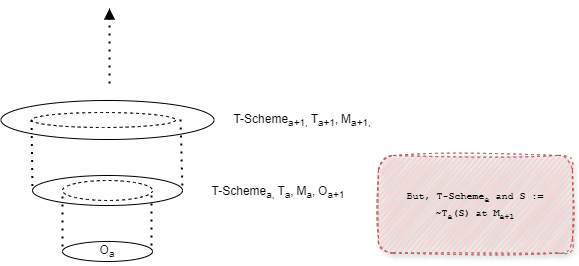Remarks on Truth-Grounding and the Liar #2
Summarizing, linking, and uniting several topics.
For the DRAFT Constraint Satisfaction and Classical Extensions of KF.
Algorithm Implementation
Additional Tarskian Considerations
Tarski 1944 defines each Meta Language Mₐ as containing a target Object Language Oₐ such that a Truth Predicate for a (Tₐ) is present in Mₐ about WFF in Oₐ (but not present in Oₐ).
Tarski's approach appears to commit one to the following:
- An infinite ascending hierarchy of languages.
- Profligate Truth Predicate Pluralism - an infinite ascending hierarchy of Truth-Predicates. Each Truth-Predicate is immanent in each linguistic ascent.
- In the absence of Bridge Laws or other subsumption laws, each ascending Truth-Predicate will express more Truths at each ascent than those below it (where
n = a + 1,Tₙdoesn't exist inMₐand so WFF withTₙdon't exist at all belown). So, each Truth Predicate fails to express the totality of truths (e.g. - all> a) at each levela. It's a Partial Truth Definition at each level. - Since it ascends infinitely, there's no top-level Truth Predicate capable of expressing all Truths.
- While at each level
a, the Liar Sentence is blocked fora, it can be recovered at> afora. And since each WFF (including T-Scheme at levela) is contained in each ascent, the Liar Sentence re-emerges for< natn.

How then are we justified in taking T-Scheme through such an approach:
- As a correct, universally quantified expression, schema, or law (even within the Object- and Meta Langauge hierarchy since we cannot find a top-level Truth Predicate)?
- How do we identify which Truth-Predicate we're to use given that each Truth-Predicate is Partial and there are at least
n-manysuch predicates for each ascentn? - And why not move to
n+1since the ascentnis contained inn+1? (Why one ascent level over another?)
We might distinguish between a more conservative approach and the sketch outlined above:
- On such a conservative approach, only Object Langauges one "level" (ordinal) lower are included in each Meta Language so that no Truth Predicates are imported by way of including lower ordinal Meta Langauges. (It's "conservative" precisely in that sense, only one language ascent is included within each Meta Language and not all of them.)
- But then we run afoul of Logical Skepticism since we are forced to ascend indefinitely to prove the justification of any particular language level. (And here such worries probably do matter even if we are followers of Crispin Wright since we are reasoning about Deductive systems of absolute certainty afterall.)
- And again we would be committed to Profligate Truth Predicate Pluralism but with the additional limitation that there's no single top-level Truth-Predicate able to talk about all Truths below the current Object Language "level" (ordinal). Truth is then strictly immanent (within and bound to) specific language ascents.
- How then do we explain translations between languages (Artificial or otherwise), representation theorems, and the like? Through isomorphism? It's not at all clear that all Natural or Artificial languages of relevant comparison share all the relevant features sufficient and necessary for isomorphism.
- How then we explain comparing language systems (like we presently are) since Truth would appear to be bound to a specific language (per the above) and no lower ordinal Truth Predicates would be imported into such a context of comparison?
- Remarks on Truth-Grounding and the Liar
- Remarks on Truth-Grounding and the Liar #2
- Ground Facts and Truth
- Ground Facts and Truth #2
- Addressing Metalogical Justification
- Propositional Stability and Cohen Forcing
- Truth as a Prosentential Operator
- The Liar Paradox in Programming
- Fun Math Stuff and the Philosopher's Stone
- Fun Math Stuff and the Philosopher's Stone #2
- Fun Math Stuff and the Philosopher's Stone #3
- Restrictionism and the Four Corners of Logic
post: 09/11/2024
update: 10/01/2024